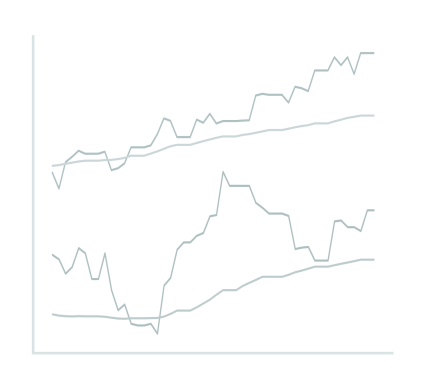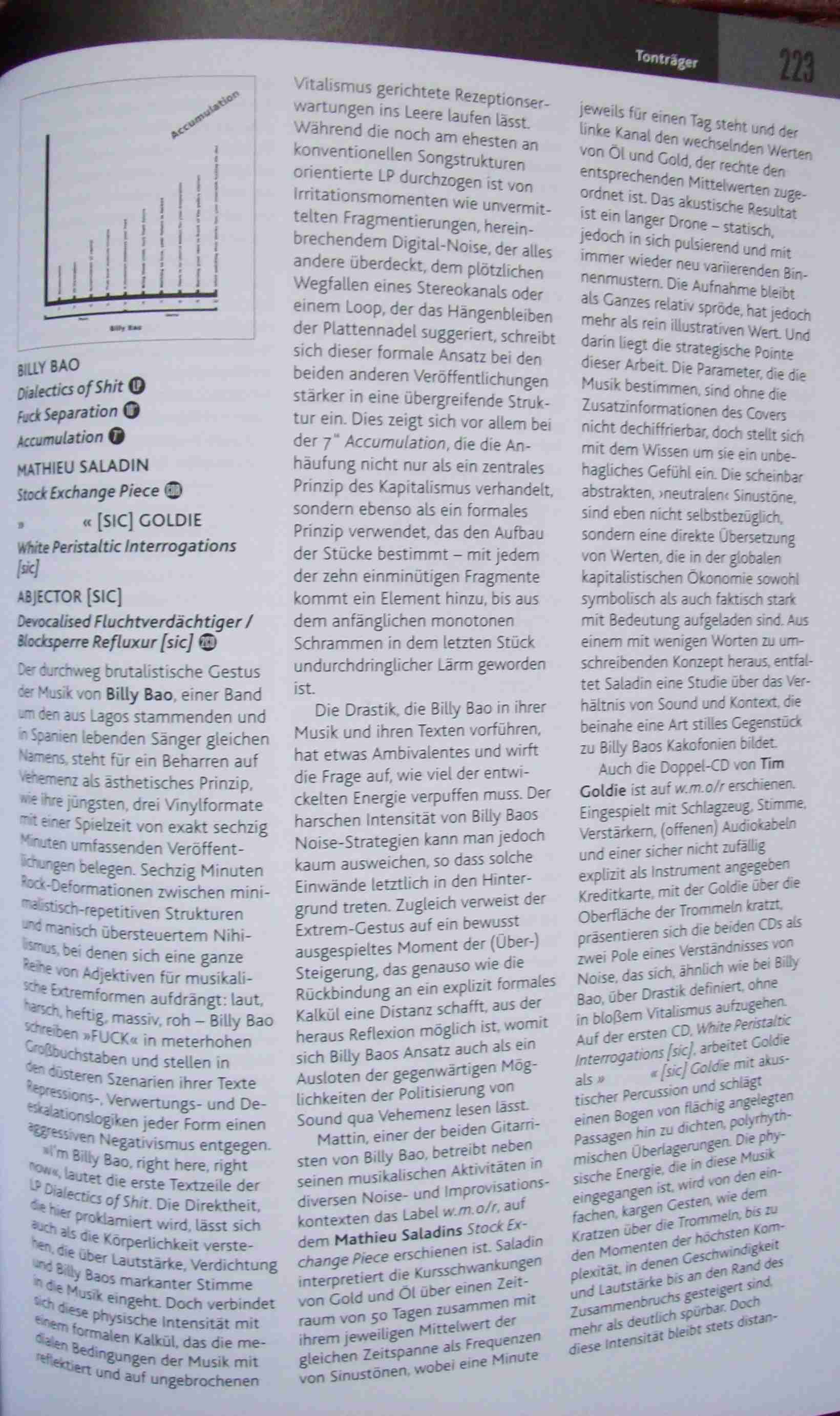w.m.o/r
32
Released August 2007
CDr edition of 200
Stock
Exchange Piece
(Gold &
Light Sweet Crude Oil)
Matthieu
Saladin

The Stock Exchange Pieces are
transpositions of rates and index of the Stock Exchange to sine waves,
with simple substitution of units. The rates fluctuations determine the
swings of resulting frequencies.
In this piece, the rates of oil
and gold and their respective 50-day moving averages (MA 50) usually
associated with them are transposed to sine waves by simply swapping
units. For example, if the oil barrel is worth 61.43 USD, the frequency
of the sine wave will be 61.43 Hz; for gold, if its index is at 648.05
USD/ounce, the frequency of the sine wave will be 648.05 Hz, etc. Thus,
the swings of high frequencies correspond to fluctuations of gold and
its MA 50 and the swings of low frequencies to fluctuations of oil and
its MA 50.
The considered period is 50
days (from March 4 to April 22, 2007) so that the moving average of the
last index is calculated from all the individual values heard during
the piece. The ratio for duration is 1 day is equal to 1 min, thus the
piece lasts 50 min. The index/frequencies are separated in pan,
according to the following distribution: rates of gold and oil on the
left, MA 50 on the right.
The sine waves move about,
converge or move away from each other, mirroring oscillations of the
Stock Exchange and thus generating acoustic phenomena in their movement
– sonic transcription of a flow.
Instrument: sine wave generator
Recorded April 22, 2007
French:
Stock
Exchange Piece
(Gold &
Light Sweet Crude Oil)
Les Stock Exchange Pieces sont
des transpositions en fréquences, par simple substitution de
l’unité, des taux et indices de la bourse. La variation des
indices détermine la variation des fréquences
résultantes.
Dans cette pièce, il
s’agit des transpositions en fréquences des indices de l’or et
du pétrole, ainsi que de leur moyenne mobile respective sur 50
jours (MA 50) telle qu’elle leur est habituellement associée
dans la présentation des cours. Par exemple, si le baril de
pétrole est à 61.43 USD, la transposition en
fréquence égale 61.43 Hz ; même chose pour
l’or, si son indice est à 648.05 USD/once, la transposition en
fréquence égale 648.05 Hz, etc. La variation des
fréquences aigues correspond ainsi à celle de l’or et de
sa MA 50 et la variation des fréquences basses à celle du
pétrole et de sa MA 50.
La période
considérée s’étend sur 50 jours (du 04/03/07 au
22/04/07) afin que la moyenne mobile du dernier indice soit
calculée sur la base de l’ensemble des indices qui se sont
succédés lors de l’écoute. Rapport de durée
adopté : 1 jour = 1 min. La pièce dure donc 50 min. Les
indices/fréquences sont séparés dans le
panoramique, selon la répartition suivante : taux de l’or
et du pétrole à gauche, MA 50 à droite.
Les fréquences
évoluent, se rapprochent ou s’éloignent les unes des
autres au gré des oscillations du marché et engendrent
ainsi dans leur mouvement des phénomènes acoustiques –
transcription sonore d’un flux.
Instrument :
générateur de fréquences
Enregistré le
22/04/07
Contact :
matthieu.saladin[at]wanadoo[dot]fr
Reviews:
============
VITAL WEEKLY
============
number 591
---------------------
week 35
---------------------
The good thing about not having money, is that one doesn't have
to worry how to make more money. I am not sure if Saladin has
money, or shares, but the stock market is the starting point for
his 'Stock Exchange Piece'. He took the rates of oil and gold
over a fifty day period, and 'translated' the fluctuations into
sine waves. So if the rate is 61.43 dollar for a barrel of oil
today, then he will pick that as frequency in sinewaves and with
the gold it's dollars per ounce (oil becomes low frequencies and
gold higher frequencies). Each day, one minute. There is a bit
which I don't understand about the 'moving averages' (MA50), but
alas I can't be economic about that. That's about it. The result,
one might ask, any good? Yes it is. The fluctuations don't jump
around a lot, but it moves up and down, and slow as it is, the
piece moves up and down in a slow. A great slow, heavy drone piece.
Frans De Ward
TOUCHING EXTREMES (Italy)
One of my most pronounced cultural limits (…alright, "culture" is an
unrecognized concept here, but let's just pretend it exists…) is the
comprehension of the mechanisms at work in the Stock Exchange market,
something which "real world" occurrences depend on, and yet I never
cared a
iota about that. Furthermore, every time I look at those sharp-dressed
operators chocking themselves while performing their specialist
language of
signs, my mind decrees that pigeons could very well be designing our
future
political and economic developments. Now, Matthieu Saladin found a way
for
this man to appreciate at least a smidgen of Stock Exchange behavioural
implications. He associated different frequencies of sine waves to the
rates
and indexes of gold and light sweet crude oil, then proceeded to
generate an
electronic composition out of their fluctuations. One would expect a
sonic
mayhem akin to a Wall Street chaos of bleeps, purrs and mumbles, right?
Wrong. What's left is a simple parallelism of high and low pulsating
undulations, whose interior movement accelerates or decelerates in a
gradually evolving pseudo-immobility. Picture a much colder, less rich
version of Eliane Radigue's "Trilogie de la Mort" and you'll get a vague
idea of how this stuff sounds like. A little more dope in the
reproduction -
speakers are mandatory - and the oscillating pulses become strikingly
muscular, resounding presences all around the house, thickness varying
depending on the position we're in. Very installation-oriented,
intelligently minimal. And you don't even need an Armani suit to enjoy
it
Bagatellen (USA)
Mathieu Saladin
Stock Exchange Piece (Gold & Light Sweet Crude Oil)
w.m.o/r
32
Saladin was responsible for a
favorite recording of mine from the
last couple of years, “Intervalles” on l’Innomable, a penetrating set
of processed reed improvisations. This is different. And puzzling.
Using a methodology you can read for yourself on the label site, he
basically transposes the values of gold and crude oil over a 50-day
stretch into corresponding sine wave units. One day equals one minute
of disc time, replete with resultant fluctuations as the two sets of
waves intertwine. It’s intriguing, not to say provocative, to use a
source like this to generate such a pure “object”. It may also be
problematic that there’s certainly no way for the listener to have
known the source unless informed outside of the sounds themselves. A
demonstration of the abstract nature of capital? An illustration of the
insubstantiality of the global marketplace? There are, after all, any
number of more or less random processes Saladin could have used aside
from those he chose. Listened purely as sound (something I find a bit
uncomfortable to do, given what I know), the piece quavers mightily
(sporting some nice bass) over its course though with little overall
change aside from a quickening or slackening of the throb. Indeed, by
moving oneself a couple of feet, the listener effects far greater
change than is otherwise heard throughout. One can, interestingly,
almost eliminate the bass at certain physical points.
Ultimately, I enjoyed it. Art’s
been made from gold and oils for a long time now, after all.
Posted by Brian Olewnick on November 14, 2007 5:57
PM
Massimo
Ricci
Testcard #18 (Deutschland, by Magnus Schaefer)



